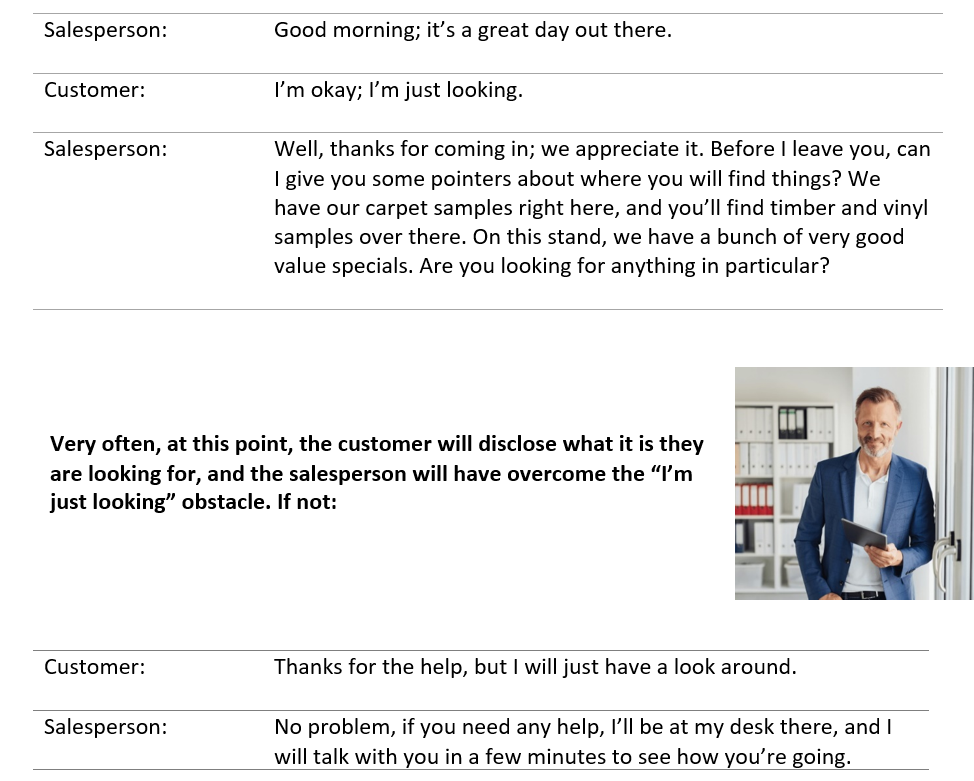Maximising Our Opportunities
There are three immutable facts about selling, and selling floorcoverings in particular:
Effective salespeople establish relationships
We can't establish relationships if we don't talk to people who come into our store
People don't go into a flooring store to kill time
The conclusion we reach when we recognise these facts is that we must engage with every person that comes into our store.
Flooring stores are not high-traffic, making it even more critical that we waste no opportunity.
Everyone on the team must understand the steps that need to be achieved before we can make a sale:
Create a warm and welcoming environment
Establish rapport with the customer
Learn the needs of the customer
Get samples into the customer's hands that meet those needs
Have the customer give us plans or let us into their home for a measure on which we can base a quote.
Rigorous follow-up
Opportunities will be wasted if we fumble the process at any of these points.
Unfortunately, we let too many opportunities pass at the first step when we accept the customer at their word when they tell us they are "just looking". Too many of our salespeople are happy to use this as an excuse to go back to their desks.
Let’s Put These Into Action!
The following exercises help maximise your opportunities:
Exercise 1 - with your sales team
Train your salespeople to overcome the "I'm just looking" obstacle.
We all say it at some stage when we are shopping. Why?
· We have just walked in, and we want to get our bearings before we talk with a salesperson
· We are not wanting a sales pitch
It doesn't mean that we won't talk with a salesperson; it means we aren't ready right now.
The best and most effective response is to let the customer know that you understand they don't want to talk to a salesperson right now but to leave them with some helpful information.
It sounds like this:
The skill we are looking for in our salespeople here goes to the first of our facts above; effective salespeople establish relationships. If the people on your sales floor can’t do this, they are not salespeople.
Exercise 2 - With Your Sales Team
Understanding the difference between pushy and helpful.
When offered tools that will help them overcome “I’m just looking”, salespeople will often resist; they don’t want to appear “pushy”.
With practice and done well, what you are proposing to your salespeople will not appear pushy to 99% of your customers. It will come across as friendly and helpful. It will capture opportunities that would have otherwise walked out of the shop.
Potentially there will be people who will interpret our efforts to help them as pushy, and we might even lose them as a potential sale. If in the meantime, we saved ten opportunities, the numbers are in our favour.
exercise 3 - management project
How successful are we at taking opportunities to the next stages; taking samples, getting measures, generating quotes?
To get a true indication of our conversion rate (from first contact through to sale/no sale), we need to know how many opportunities have presented themselves. The best way to gather this information is to have your salespeople use the RFMS CRM App. For a demo and free trial of our CRM App, click here.
However, the information is still available to you without the app. It’s just a little more work-intensive.
Here’s how:
The base number we need to know is how many opportunities (approximately) are walking in over a month. There is no easy way to get this number without at least some work. Having the data recorded manually on an ongoing basis is not sustainable, so we have to set a baseline and estimate.
This exercise has some work and cost, and it’s not 100% accurate, but the information it yields is gold.
Set up an electronic counter on your entry.
For at least a week, classify everyone that comes into the store through those doors; staff, couriers, returning customers, new opportunities, etc. You might think of a better way of doing this, but however you do it, you want to know who is walking into your store and why.
If for the period measured, you had 500 people walking through the entry, 80 were new opportunities; you have your base number; 16% of the people (80 divided by 500) coming through your door are new opportunities.
Now you have a very interesting and valuable data point. Once a week, you can work out how many walk-in opportunities you had and how this number compares to how many sample dockets were written and how many measures were booked.



